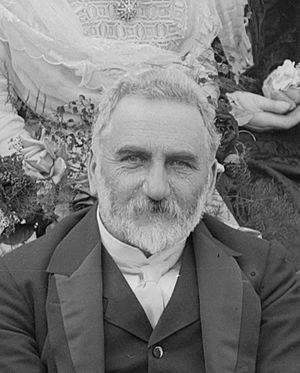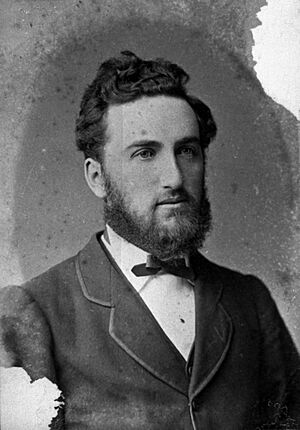Thomas William Hislop facts for kids
Quick facts for kids
Thomas William Hislop
|
|
|---|---|

Portrait of Thomas Hislop in 1908
|
|
| New Zealand Legislative Council | |
| In office 2 September 1921 – 2 October 1925 |
|
| 21st Colonial Secretary of New Zealand | |
| In office 8 October 1887 – 10 September 1889 |
|
| Governor | William Jervois James Prendergast (acting) The Earl of Onslow |
| 8th Minister of Education | |
| In office 9 July 1889 – 10 September 1889 |
|
| In office 17 October 1889 – 24 January 1891 |
|
| Member of the New Zealand Parliament for Waitaki |
|
| In office 10 January 1876 – 28 April 1880 |
|
| Member of the New Zealand Parliament for Oamaru |
|
| In office 20 May 1885 – 3 October 1890 |
|
| 16th Mayor of Wellington | |
| In office 1905–1908 |
|
| Personal details | |
| Born | 8 April 1850 Kirknewton, Scotland |
| Died | 2 October 1925 (aged 75) Wellington, New Zealand |
| Resting place | Karori Cemetery, Wellington |
| Spouses | Annie Hislop (née Simpson; m. 1873–1909) Louis Hislop (née Smith; m. 1922–1925) |
| Children | Thomas Hislop |
| Residences | Sayes Court, Wellington |
| Alma mater | University of Otago |
| Occupation | barrister and solicitor; politician |
| Cabinet | Atkinson Ministry, 1887–1891 |
Thomas William Hislop (born 8 April 1850, died 2 October 1925) was an important figure in New Zealand politics. He served as the Mayor of Wellington, the capital city, from 1905 to 1908. He also represented two areas in the South Island as a Member of Parliament. Later in his life, he was part of the New Zealand Legislative Council, which was like an upper house of Parliament.
Contents
Early Life and Education
Thomas William Hislop was born in Kirknewton, Scotland, in 1850. His father, John Hislop, became the very first Secretary for Education in New Zealand. This meant his father was in charge of setting up the education system for the whole country.
In 1856, when Thomas was six years old, his family moved from Scotland to New Zealand on a ship called the Strathmore. They landed in Port Chalmers and settled in a place called East Taieri.
Thomas was taught by his father until he was twelve. After that, he went to John Shaw's Grammar School and then Otago Boys' High School in Dunedin. He continued his studies at the University of Otago, where he chose to study law.
In 1871, he became a lawyer, which means he could work as a barrister and solicitor. One of his teachers from school, Robert Stout, who later became the Prime Minister of New Zealand and then the Chief Justice of New Zealand, also became a lawyer around the same time. Thomas Hislop worked as a lawyer in Oamaru until 1890. After that, he moved to Wellington and joined a law firm there.
Becoming a Politician
| New Zealand Parliament | ||||
| Years | Term | Electorate | Party | |
| 1876–1879 | 6th | Waitaki | Independent | |
| 1879–1880 | 7th | Waitaki | Independent | |
| 1885–1887 | 9th | Oamaru | Independent | |
| 1887–1889 | 10th | Oamaru | Independent | |
| 1889–1890 | 10th | Oamaru | Independent | |
Thomas Hislop started his political journey by being elected to Parliament for the Waitaki area in 1876. He was re-elected in 1879 but resigned in 1880 for personal reasons.
He then represented the Oamaru area from 1885. In 1889, he resigned from his government jobs and his seat in Parliament. However, he won the special election (called a by-election) that followed. He lost his seat in the next general election in 1890 to Thomas Young Duncan.
Important Roles in Government
Thomas Hislop was a member of the government led by Harry Atkinson from 1887 to 1891. During this time, he held two very important jobs:
- Colonial Secretary: This role was similar to a modern-day Minister of Internal Affairs, dealing with many different government matters.
- Minister of Education: This job was especially meaningful to him because his father had played a big part in creating New Zealand's education system. Thomas Hislop was proud to follow in his father's footsteps.
As a minister, he worked on several new laws. He helped create the Fair Rent Bill, which aimed to make sure rents were fair for people. He also worked on laws to improve conditions for workers, such as factory and shop hours, and rules about employers' responsibility for their workers' safety. He successfully passed the Shipping and Seamen's Act, which helped regulate ships and their crews.
Thomas Hislop's political ideas were generally focused on helping ordinary people and workers.
In 1889, he was involved in the Paris Exposition, a big world fair held in Paris, France. For his work there and his contributions to education, the French Government gave him a special award called the Legion of Honour.
Later Political Efforts
After his time as a Member of Parliament, Thomas Hislop continued to be active in politics. He ran for Parliament in the Wellington area in 1899, and for the Newtown area in both 1902 and 1905, but he was not elected.
From 1905 to 1908, Thomas Hislop served as the Mayor of Wellington. This was a very important role, as he was in charge of leading the city.
Later in his life, from 1921 until his death, he was a member of the New Zealand Legislative Council. This council was a group of appointed members who reviewed and approved laws, similar to a second house of Parliament.
Family and Legacy
Thomas Hislop lived in a house called Sayes Court in Wellington, which was considered a very valuable property.
He married Annie Simpson in 1873. They had two sons and three daughters. Sadly, Annie passed away in 1909. One of their sons, also named Thomas Hislop, later followed in his father's footsteps and became the Mayor of Wellington from 1931 to 1944.
In 1922, Thomas Hislop married Marguerite Estelle Louis Smith.
Thomas Hislop passed away on 2 October 1925, at his home in Wellington. He was buried at Karori Cemetery in Wellington. He is remembered for his long career in public service and his contributions to New Zealand's government and education system.
List of Honours
 Officier de la Légion d'Honneur (France)
Officier de la Légion d'Honneur (France)


